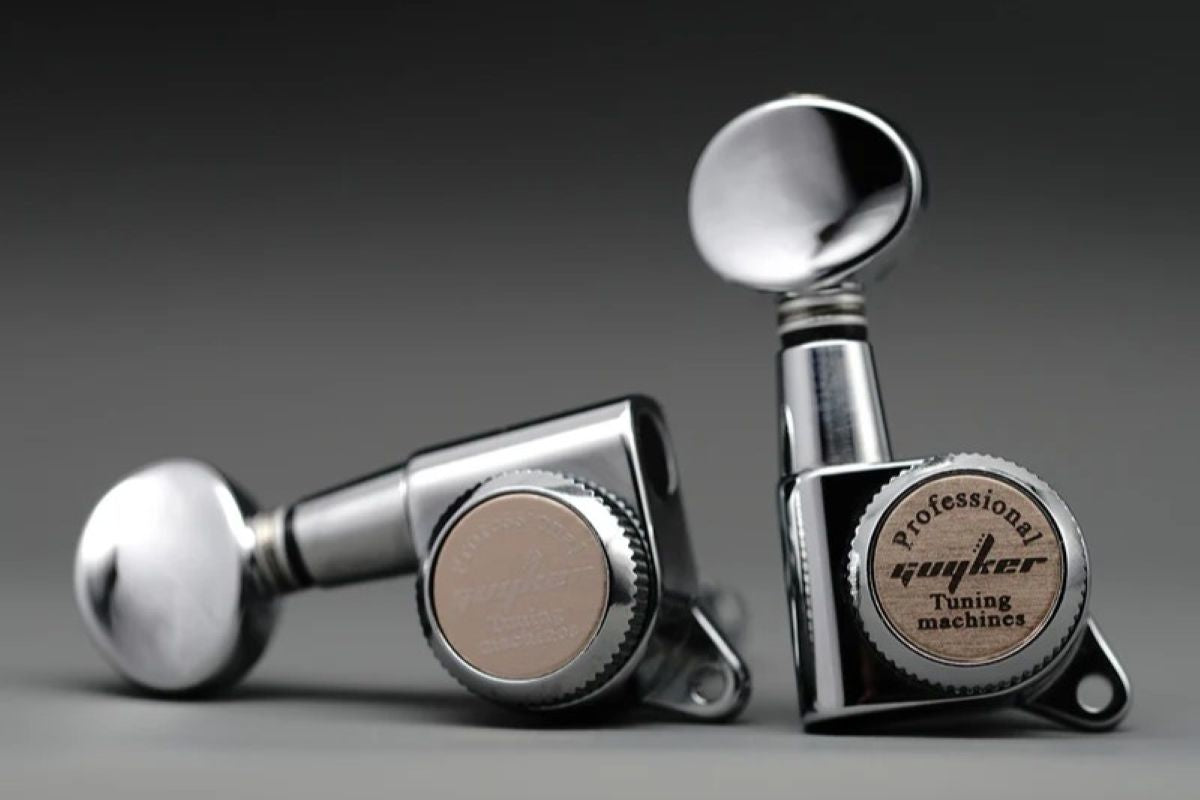Tuning stability is one of the most important aspects of guitar playing. Whether you're a beginner just starting off, strumming chords in your bedroom, or a seasoned performer recording your own songs and performing on stage, there’s nothing as musically frustrating as a guitar that constantly slips out of tune.
This is why your beloved guitar needs a set of locking tuners!
Locking tuners (also known as locking tuning machines or locking machine heads) are an excellent upgrade from standard tuners and feature a mechanism to secure the string firmly in place, preventing slippage and ensuring tuning stability.
Traditional tuners rely on multiple wraps of string around the post to hold tension, whereas locking tuners use a clamping system - usually a thumb screw or a cam - to lock the string directly into the post. This not only simplifies string changes but also provides improved tuning stability because it minimizes string movement.
What are the Benefits of Locking Tuners?
The main benefit of installing a set of locking tuners on your favorite guitar is improved tuning reliability.
Standard tuners often suffer from string windings loosening over time, especially if you bend aggressively or love using your tremolo. Locking tuners don’t have this problem because there are far fewer wraps (usually just one), massively reducing the chance of string slippage. This is even more important if you play a guitar with a floating bridge.
Other benefits include making restringing much faster and easier. This might surprise some of you, especially when you consider the time taken to unwrap each string from its packaging and threading it through your bridge or stop tailpiece.
However, the fact that you don’t need to wind the string for ages around each tuner post really adds up, and I estimate that you’ll change a whole set of guitar strings about 25 to 33% quicker than with standard tuners.
Guyker GK-501D7SP BK/GD Locking Electric Guitar Machine Heads
An Easy Upgrade, but not Always!
Get everything right, and upgrading to a set of locking tuners is very simple. However, if you don’t do your homework, it can quickly turn into something a lot more complicated.
100% compatibility with your guitar's headstock is a must because hole sizes and alignments vary between makes and models. Therefore, gather as much information about your chosen tuners as possible, most critically their diameter and peg hole requirement.
Then compare this with your guitar; you might need to remove one of your current tuners to measure the hole correctly. Also note the position of any screwholes or alignment pins and, in a perfect world, make sure they align.
If you can’t find the information online, contact the manufacturer and ask for it. If you don’t get a reply, move on to more responsive manufacturers.
Most locking tuners require 10mm (3/8") holes, which is relatively standard, but some manufacturers, and especially vintage guitars, have smaller holes - normally 8.5mm.
Get this wrong, and your guitar may require slight modifications, such as enlarging the holes in your headstock or having to fill old screw holes. Both of which are best avoided if possible.
For more information, check out How to Buy the Correct Tuning Machines for Your Guitar.
So, let’s go through the locking tuner installation process step-by-step, starting with the…
Tools and Materials
Before starting, make sure you have everything you could need close to hand. These are…
Basic Tools
-
Phillips or flathead screwdriver (depending on your tuners' screws)
-
10mm wrench or socket for tightening nuts
-
Ruler or straight edge for alignment.
Drilling
-
Power drill with small bits (1/16" and 3/32" or as specified for your tuner) for pilot holes if alignment pins are needed.
-
Masking tape to mark drill depths and prevent over-drilling.
Guitar Care
-
Masking tape or painter's tape to protect the headstock finish from scratches
-
Soft cloth for cleaning.
Optional Equipment if Needed
-
Reamer or step drill bit if the tuner holes need to be enlarged
-
Wood filler or dowels for plugging old holes if the alignments don't match
-
Small piece of card to protect the body if your guitar has a floating bridge.
Materials
-
Locking tuners
-
Set of strings
Guyker GK-504SP 3R3L Guitar Lock String Tuning Pegs
Preparation
The key to successfully completing any DIY task is preparation.
To start, remove the old strings. Loosen each one from its tuning peg and then cut them near the bridge for easy removal, as always, be careful not to scratch the finish.
Once the strings have been removed, unscrew the old tuners from the back of the headstock. For the bushings on the front, gently pry them out with a small screwdriver wrapped in tape to avoid any damage. Store the old hardware in a bag; you never know when you might need it.
Now, physically confirm the compatibility of your new tuners with your guitar by placing them in one (or all) of the holes. If you do need to enlarge the holes, carefully use a reamer to avoid cracking the wood.
Next, clean the headstock thoroughly with a soft cloth to remove any dust, oil, or residue. If your guitar features a tremolo system, insert a small piece of cardstock under the bridge to stabilize it and protect the body during the installation.
This is a great time to inspect for any damage. For example, if the screwholes are worn, consider filling them with wood dowels and redrilling for a fresh start.
If the new tuners' alignment doesn't match the old holes (for example, different pin placements), you'll need to plug the old holes. The best way to do this is to use wood filler or toothpicks that have been coated in glue. Then let the filler or glue dry, and sand carefully. If needed, you can use a spot of car touch-up paint to match the headstock color after the installation is complete.
Step-by-Step Locking Tuning Machine Installation Process
Step 1: Position the New Tuners
Insert the new locking tuners into the headstock holes, starting with the ones that are closest to the neck for stability. Make sure that they sit completely flush with the surface of the headstock; if not, gently ream the holes.
Next, place a straight edge or ruler along the tuner posts to check alignment - they should be in a straight line parallel to the edge of the headstock. If everything looks good, finger-tighten the front nuts to hold them temporarily in place, but don't overtighten them quite yet.
Step 2: Mark and Drill for Alignment Pins (If Needed)
Many locking tuners, such as those manufactured by Fender, have anti-rotation pins or nubs to prevent the tuners from twisting.
With the tuners in place, note the small indentations that they make on the wood. Now remove the tuners, then apply masking tape onto a 1/16" drill bit to mark the drill depth, which should be about 1/4" to avoid coming out of the front of the headstock.
Drill a pilot hole at each indentation mark. Now switch to a 3/32" bit (or a size that matches the pins) and drill the full holes, again remembering to use tape to control the drill depth.
Then test fit each tuner; it should now sit perfectly flat without rocking.
Step 3: Secure the Tuners
Next, it’s time to reinsert the tuners, aligning them with the straight edge. Now, screw in the mounting screws if your tuner uses them. Then, use a 10mm wrench to snugly turn the front nuts.
Don’t fully tighten one tuning machine, then move to the next; tighten them evenly to avoid stressing the wood. Also, remember to flip the guitar over every now and then to make sure everything is still in perfect alignment.
Step 4: Install the Locking Mechanisms
Depending on the tuner design, you now need to attach any locking caps or thumbscrews. These normally thread onto the posts.
Step 5: Restring the Guitar
Welcome to the wonderful world of locking tuners - your string changes will never be the same again!
Thread each string through the bridge and up to the tuner post. Now pull it tight - gone are the days of endless windings! - then insert it into the post hole. Next, tighten the locking mechanism (e.g., using a thumb screw) to clamp the string.
Tune to pitch as normal, aiming for about three-quarters to one full wrap around the post to achieve the optimal break angle over the nut. Then cut the excess string lengths with wire cutters, and you're ready to rock.
Guyker GK-102SP Locking String Sealed Tuning Key Pegs
Worried about installing locking tuners yourself?
That’s completely understandable; damaging your prized instrument isn’t fun. Thankfully, since it’s a relatively easy upgrade, it won’t take a luthier much time to do the work for you. Depending on the guitar, you could expect to pay between $50 and $100, which is well worth it if you have any doubts about your own DIY abilities.
Need some locking tuning machine recommendations?
No problem, check out my look at the 10 Best Locking Tuners for Electric Guitars.
Wrapping it Up!
So, there you have it, my in-depth step-by-step guide to installing locking tuners.
This relatively easy and extremely rewarding DIY project will produce a noticeable improvement in your guitar's performance, providing rock-solid tuning, quicker string changes, improved playability, and fewer headaches.
Plus, it shouldn’t cost the earth, with lots of fantastic options available in the $50-150 range. But don’t rush the job, remember that patience is key - measure twice, drill once.
The very best of luck with your installation!


Share:
Is it Better to buy a Cheap Guitar and Upgrade, or buy a High-End One?
Different Types of Electric Guitar